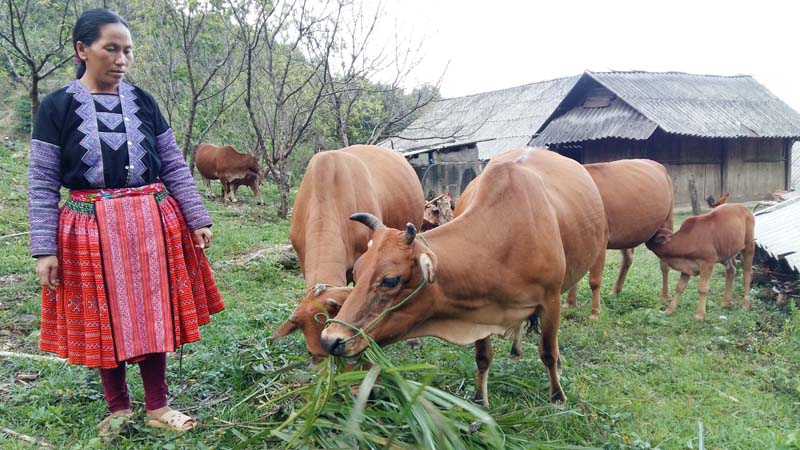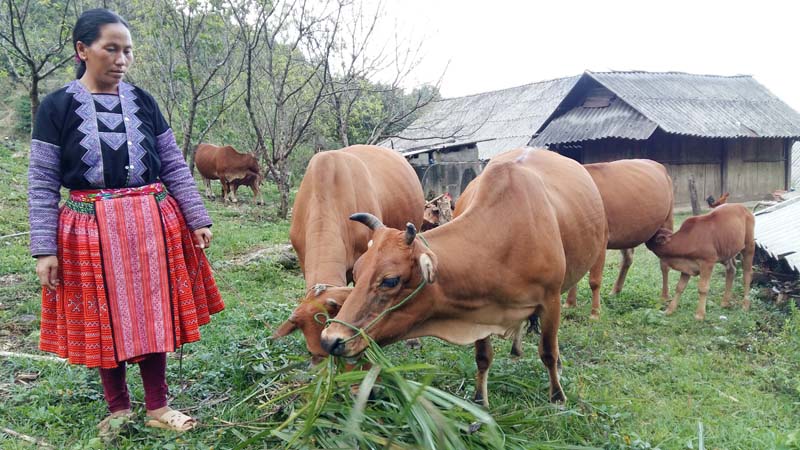
(HBO) – A smooth concrete road leads to Hang Kia commune, Mai Chau district, cows graze on the hill slope, and chickens run on houses’ yards. The picture demonstrates the better life of H’Mong ethnic people in Hang Kia.
has a sustainable livelihood from cow breeding after becoming
involved in a local poverty reduction project.
In 2012, Vang Y My, together with other women in Hang Kia 2 hamlet, received a
loan to buy a breeding cow under the project. My also received assistance in
the form of training from the project in taking care of her cow. After five
years, the cow gave birth to four calves, helping her family escape from
poverty. Now, she also raises chicken and pigs, and grows corn, plums and
edible canna to increase her income.
From 2016 – 2018, the project focused on improving infrastructure and living
conditions of H’Mong ethnic people in the area, which was an especially poor
area. A 50 cubic-metre water container in Thung Mai hamlet was built, ensuring
clean water supply for 53 local households, even in dry season.
Under the project, a communal house in Thung Man hamlet was put into use. The
commune road network was also significantly improved. Inter-hamlet roads in
Hang Kia commune were concretised at a cost of 1.7 billion VND. Concrete roads
to fields in Thung Mai, Pa Khom, Thung Man hamlets have also been made to
facilitate transport of materials and agricultural products, each costing
around 300 million VND (13,200 USD).
Kha A Pao, a member of Hang Kia commune’s development board said infrastructure
construction and livelihood assistance sub-project were particularly useful for
local residents. Thanks to roads, clean water supply stations and communal
houses built with support from the project, the living conditions of locals
have remarkably improved. All works were implemented effectively under close
monitoring and inspection. Livelihood assistance was made with careful study,
thus proving effective to reduce poverty in a sustainable manner.
Hang Kia commune is a disadvantaged area with low per capita income average,
and more than half of the commune’s household living under the poverty line.
The project has helped ease the difficulty and improve the living and
production conditions of H’Mong people in the commune. Dozens of poor
households now have stable livelihoods like Kha Y Do, Vang Y My in Hang Kia 2
hamlet, and Kha A Tru in Thung Mai hamlet.
The emulation movement "Hoa Binh joining hands to build new-style rural areas” has been widely spreading, becoming a driving force that motivates the localities to renew rural landscapes and improve the material and spiritual lives of the residents. In this movement, the people play a central role-both as the main implementers and direct beneficiaries of its outcomes.
In response to the global digital revolution, Hoa Binh Newspaper is transforming itself into a modern and multi-platform media hub, blending cutting-edge technology with a restructured newsroom and a new generation of tech-savvy journalists.
Hoa Binh province’s Association of the Elderly recently held a conference to review the project on expanding the inter-generation self-help club model until 2025.
In a move to implement Resolution No. 57-NQ/TW, issued on December 22, 2024 by the Politburo, which targets breakthroughs in science-technology development, innovation, and digital transformation, the Hoa Binh provincial Department of Health has issued a plan to roll out the "Digital Literacy for All” campaign within the local health sector.
An Nghia Commune (Lạc Sơn District) is one of the communes that achieved the tha standard of the national new rural area in 2018. Entering a new development phase, the commune is now trying to meet the criteria for the advanced new rural development. With the strong political will and the public consensus, the commune is gradually overcoming the challenges to reach this goal, aiming for the sustainable development.



